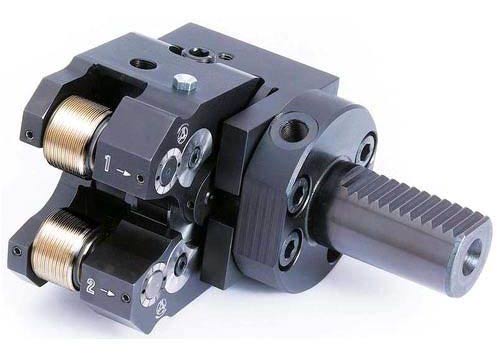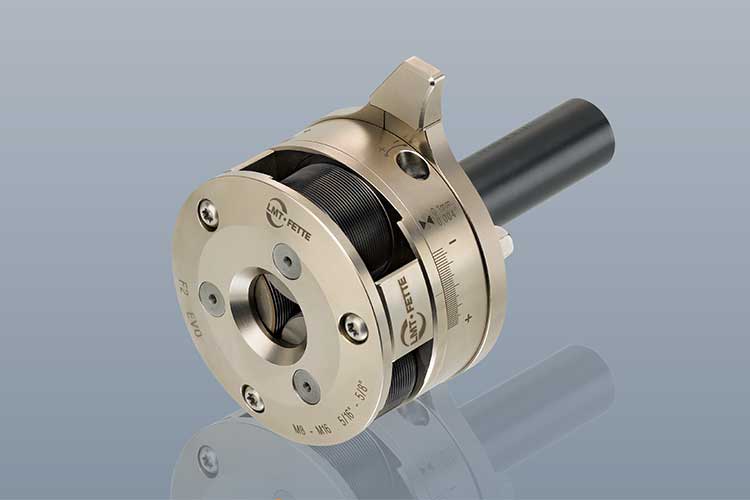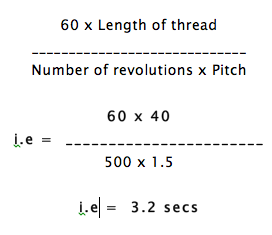For many CNC applications, thread rolling, is the best choice for creating higher quality external threads in a single pass, Chipless operation.
Thread rolling technology has been resorted to on multi spindle machines, engine lathes, dedicated rolling machines for decades. However, rolling threads on machines that are not dedicated to a single part / operation is a relatively new and unfamiliar concept. It offers particular advantages on NC and CNC machines as it eliminates the costly multiple passes required in single point threading. Producing the thread in only one pass can reduce threading time by as much as 90%!
Today’s CNC machines are very versatile and can be changed over quickly to help meet demands for JIT manufacturing. A more striking benefit of CNC machines is its ability to produce higher quality parts more quickly and efficiently. Tool changes are faster and adjustments can be made without stopping the machine.
Like the CNC, single point threading is also very versatile. Most of today’s single point threading is performed by indexable insert tools as part of a very rapid CNC process. A typical part that requires a thread is routinely accommodated through fixed cycles of numerical control and a variety of other machine mechanisms. This can be a very economical method of producing smaller quantities of parts.
However, when parts are produced in larger quantities, single point threading’s versatility is less beneficial. This is because, in order to maximize effective tool life, single point inserts are processed with a limited depth of cut with multiple passes needed to cut to the thread’s full depth. The time needed to take these multiple passes can create a bottleneck. Additional passes may also be taken to deburr the thread, requiring more machine tool time or a secondary operation outside the machine. Although CNC is bringing down the total threading cycle times by making non cutting functions more efficient, these time savings are negated by the added time it takes to single point the thread. Thread rolling on the other hand, produces threads in one pass, reducing expensive CNC machining time. In addition, when a thread must be rolled, the use of a thread rolling head – attachment on CNC equipment can complete the workpiece in one single set up thereby eliminating a secondary operation on a separate thread rolling machine.
Chipless Cold Forming
Technical Advantage
In addition to doing more work on one machine in less time, thread rolling has many technical advantages over single point threading. Instead of cutting or shearing the material as is the case of single point threading, thread rolling cold forms the profile to be produced. In this process, the component material is stressed beyond its yield point, being deformed plastically, and thus permanently. A hardened die made from tool steel or HSS displaces the material along the contours of the thread profile, plastically deforming the material into the final form. The workpiece material is stressed beyond its yield point, which causes it to flow and conform to the mirror image of the die’s profile – refer to figure 1.
- Stronger Threads
The grain lines of the rolled material aren’t interrupted like those of cut material: they are compressed and moved more perpendicular to the centerline of the part, increasing the thread’s tensile strength by 10% to 30% over cut threads. This aids in resisting tensile forces acting against a thread, which pulls along the centerline of the part. Parts that can benefit from this increase in tensile strength include cylinders, piston rods, tie rods etc.
- Burnished Thread Flanks
The compression of the material during the rolling operation causes workhardening at the thread’s surface. This is most apparent in the thread’s root and along its flanks, making them more wear resistant. The compression of material to the die’s form provides a very exact profile with a surface finish better than grinding can achieve. Shearing a material produces a rough surface finish, but, compressing it produces a smoother and harder surface finish, resulting in greater resistance to wear, corrosion and galling. This improved resistance to wear is a particular benefit for Valve stems and other parts that are susceptible to harsh, corrosive atmospheres. Nuts that must travel freely over long distances in contaminated atmospheres also benefit from the smooth surface finish.
- Improved Wear Resistance
A rolled thread also has up to 70% increased fatigue resistance over a cut thread. Since rolling is a chipless operation, the profile is free from burrs, tear marks, chattering marks, and sharp exit points, all of which are focal points for stress. The smooth, burnished surface of a rolled thread has fewer hills or valleys where stress can build up and cause the part to fail from fatigue. This characterestic is most beneficial at the thread run out , or distance of unusable or incomplete thread. If a part were to fail from fatigue, it would fail here at the end of the thread, where the entire load is concentrated. Parts that are under constant load greatly benefit from thread rolling because the threads have a smooth work hardened, radiused and burnished runout.
- Profile Accuracy
With thread rolling, thread quality is more consistent from part to part than with single point threading. Even with the best grind possible, a single point threading insert will start to wear the moment it touches metal. The longer the thread to be cut, the greater the potential for deflection and chatter, resulting in shorter tool life. However, the dimensions of thread rolling dies do change with use. Every time the die rolls, they gain stress. The stress builds up to a point where the hardened material of the die just fatigues and breaks away in small pieces at the crest where the die is doing the most work. Upto this point, the dies will make the same profile every time. Practically no adjustments are needed throughout the life of the rolls, which is typically tens of thousands of parts per set.
Economic Advantage
- Material savings
Since thread tolling displaces material rather than removing it, smaller stock can be used to produce a given thread diameter than must be used with single – point threading. Whereas single point threading is a reductive process, thread rolling actually increases the part’s diameter to the thread’s outer diameter. Therefore, the thread rolling diameter of the blank is not as in single point thread cutting, where it is identical with the outside (major) diameter of the thread, but , is the pitch diameter of the thread. With many workpieces, this means a considerable saving on material, especially if the material has been drawn to the pitch thread diameter when it can be used immediately. In addition, thread rolling may negate many of the chip problems associated with materials such as SS 304, Inconel and titanium.
- Extremely short machining time
Rolling speeds ranging from 20~90 m/min are considerably higher than the cutting speeds used in Thread cutting operations. When cutting with thread chasing heads, speeds rarely exceed 10 m/min. Thus when using the thread rolling processes, the net thread rolling time will never be the deciding factor.
For e.g.:
Threading a M 16 , 19mm on a cast steel journal, the time to thread cut was 4.8 secs per piece. However, when rolling was performed, only 0.8 secs were required with an axial type rolling head and 0.2 secs with a radial type head.
- Longer Tool Life
For any thread rolling process performed with LMT FETTE attachments and rolls, the long tool life of the thread rolls gives extremely low tool costs. Refer to the table below for an example:
| Thread | Thread Length | Material | Type of process | Tool life of one set of rolls |
| M5 x 0.8 | 15 mm | AISI 1117 | Axial | 120,000 components |
| Tr.30 x 6 | 600mm | AISI 1020 | Axial | 35,000 components |
| M16 x 1.5 | 22mm | AISI 5140 | Axial | 30,000 components |
| M20 x 1.5 | 16mm | AISI 1213 | Radial | 250,000 components |
- Full utilisation of the machine
The well designed LMT FETTE thread rolling heads are compact units needing a rotary motion in order to function properly. To meet that requirement, simple turning lathes will suffice. But, these rolling heads can also be used on Turret lathes, automatic lathes and CNC Lathes, giving thread production without problems on any workpiece, able to accommodated in the machine, in a short part of the total cycle time.
Thread Forms
Thread rolling is applicable to many standard and special thread forms. Besides common 60° profiles, other types of threads that can be rolled include Parallel and tapered “V” Type threads, Acme, Knuckle, and in some cases Buttress. However, it should be noted that as long as the Flank angle is not less than 10 ° practically any special shaped thread can be rolled between 1.4mm and approximately 230mm. In addition, depending on the specific application, it may be possible to reduce tube diameters, swage the ends of tubes, roll annular ring profiles, mark logos, letters and numbers.
Work Piece Material
Within certain given physical parameters, practically any work piece material can be thread – rolled, including structural steels, case hardened steels, stainless steels, heat treatable steels, Aluminum, and nickel based alloys such as Inconel 718.
The three main physical parameters that determine whether rolling is feasible are
- Elongation factor
As the material will be plastically deformed by pressure, it should have a minimum elongation factor of 5% to 7%. Cast Iron, pure bronze, hard brass alloys and other hardened materials that have less than 5% elongation are too brittle to be thread rolled.
- Hardness & Tensile strength
As a general rule Hardness should not exceed Rc 40, and the material Tensile strength should not exceed 1700 N/mm2.
Chemical composition also can be a factor. The work piece material should not contain more than 1% lead additives for free machining. In addition, the type of profile and the amount of displacement have a direct impact on the material’s ability to be rolled.
The work piece material to be rolled may affect the choice of thread – rolling head / attachment, surface treatment on the thread roll, and thread – rolling system. There are three main systems:
Axial, Tangential and Radial.
Axial
The axial system comes from the front end of the part along the centerline – refer to figure 6. While thread lengths produced by the other two systems are limited to the width of the rolls, the axial system is designed to produce unlimited thread lengths. The thread form on the axial rolls consists of straight annular rings that are ground to the pitch of the thread to be produced. The rolls are positioned in the head at a skew angle that is approximate to the thread’s helical angle, producing a forward motion ; hence, the threads are self – feeding.
If the first ring on the axial roll were full profile, it would do all the work. Therefore, similar to a chamfer on a tap, a progression or lead is required to help the rolls start and to provide better tool life. By having more progressive rings on the rolls, tool life can be optimised on longer profile lengths.
A shorter progression can be used to allow threading up closer to a shoulder, but the rolls wont have a long tool life. The closest that the axial system can thread to a shoulder is approximately 1.5 times pitch. Where, it is desirable to thread very close to the shoulder, a Tangential or Radial thread – rolling system will do a better job.
Although the axial system cant thread as close to a shoulder as the other two systems, it has the unique advantage of threading larger diameter stock. Since the axial rolls only produce one thread at a time, the heads are simpler in design. This leads to a greater diameter capacity. Currently, the FETTE axial systems can roll profiles upto 230 mm in diameter.
Tangential
The tangential system uses one roll above and one below the work piece. The rolls are fed from the side ( X – axis), pressing deeper with each revolution of the work piece. When the centerline of the rolls in line with the centerline of the work piece, usually between 15 to 30 revolutions, the forming process is completed – refer figure 7. Neither the work piece nor the rolls move axially. Therefore the length of the thread that is formed depends on the width of the roll. Therefore the length of the thread that is formed is dependent on the width of the roll.
The tangential systems use helical profiled rolls that are mounted on straight stationary spindles. The thread helix angle to be produced is ground onto the roll ; in other words, it is a mirror image of the thread. Therefore it is just a matter of using left hand rolls to produce left hand profiles and right hand rolls to produce a right hand profile. However, the same attachment can be used with either type of roll.
The rolls are chamfered at both ends to provide a base of support for better roll life. The length of the chamfer is equal to the thread runout, or distance of unusable or incomplete thread to a shoulder, which is approximately ½ to 1 times the pitch. Therefore, it is possible to thread very close to a shoulder.
Tangential systems can be conveniently mounted on the cross slide of screw machines, automatic lathes and CNC lathes.
Cycle Times
All systems produce the thread in ONE pass, thereby eliminating the costly multiple passes required in single point threading and reducing threading time by as much as 90%.
Since the axial system is the only one that produces one thread at a time, its threading cycle time will be dependent on the length of the thread. For eg: Lets calculate the cycle time for a thread that is M 20 x 1.5, length of 40 mm long. The rolling time in an axial system would be:
The savings in machining time that thread rolling can provide over single point threading can be enough to justify the investment in a thread rolling system.
Tooling costs, Machine time and Parts per shift
Considering the fact that the cycle times are so low for thread rolling , it would translate into savings of machine time and optimum machine utilisation . Further, a shop can reduce cutting tool costs and decrease downtime if it rolls threads rather than cuts them. The roll life for most applications are relatively high, thereby ensuring reduced downtime. By implementing thread rolling, the parts per shift will dramatically increase when compared to thread cutting.
Machine Options
Since it produces threads in one pass, thread rolling requires more horsepower than single point threading. However, the power requirements for thread rolling typically are less than the capacity of modern machine tools.
Thread rolling creates a tremendous amount of heat very quickly. Since the surface of the thread is constantly changing during the forming operation, this heat is dissipated very easily into air moving around the rotating workpiece or thread rolling head/ attachment – hence the term “Cold Forming”. Using a water soluble coolant also dissipates heat and helps extend the life of the roll.
FETTE Thread rolling heads/ attachments can be used on almost any type of machine tool, including CNC automatic lathes, basic engine lathes, rotary transfer machines, and machining centers.
As long as the head / attachment and the workpiece can be positioned properly, the thread rolling process can be employed virtually without any restriction. However, because today’s CNC machines are designed as smaller, more compact units, thread rolling head / attachment clearance may be a factor which needs to be looked into during the selection process.
Initial Cost
To potential customers, the initial cost of a thread rolling system may seem like a significant stumbling block. Initial costs for single point thread rolling systems are minimal compared to those for thread rolling systems.
While the initial costs of all three types of thread rolling systems are higher than single point threading systems, the long – term costs are lower due to longer tool life and substantially shorter machining times. Although initial cost savings may be a more tangible benefit, customers must consider the techincal and economic advantages offered by thread rolling in the long term.
Courtesy: LMT India Pvt Ltd






